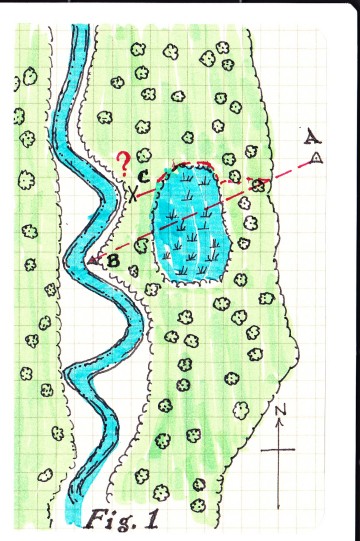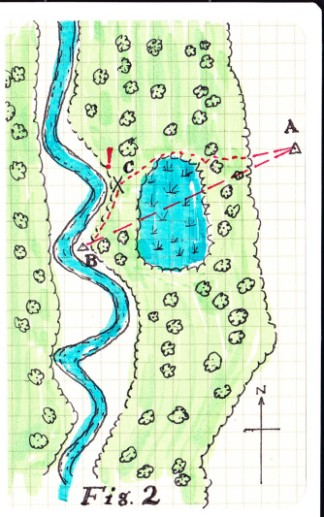
*Aiming Off*
If you’ve ever taken a compass course, whether in the military or in the Boy Scouts or wherever, you have likely encountered this confounding circumstance.
You are traveling by foot through a typical American forest, along a course toward a point on, say, a small river or stream. Let’s make the exercise more interesting by saying that the point you wish to arrive at is a concave portion of said stream—in other words, a place where the landmark will wrap around you. You take your azimuths as carefully as you can, and you do so often, as is always taught for navigation in close woods. You find that you have a marsh to cross and, upon arriving at it, conclude that the wiser course is to go around it. You get to the opposite side, ‘round about where you think your course should lie (your pace count is all a-shred by now), but presently you reach the stream more or less where you expected it to be.
But behold! The point at which you expected to arrive is not concave, but convex! It does not wrap around you, but rather bends away from you in each direction, as shown in the sketch below:

It’s the right river; says so right here on the map—you could have crossed no other. And you were careful in your measurements, as careful as can be. But facts are facts and here you are, at a particular spot on a river, which looks exactly like every other spot on the river for as far as you can see through the underbrush. Time to choose. You must now decide whether to go right or left; and from your vantage point, you have no idea which course is the wiser, for one choice looks exactly like the other. Guess carefully, though, for dusk approaches; a wrong guess could leave you floundering aimlessly in the great vastness of Godforsaken, and in the dark, no less.
Do not feel like a poor tenderfoot if this happens to you. You are only doing as you’ve been taught; shoot an azimuth, check the azimuth, pace the distance, and guesstimate around obstacles too difficult to push through. Too easy. And yes, that’s just what it is: too easy. I was taught to do this very thing in every land navigation course I took in the Army. Often, it is prudent to do simply what we’ve been told. A landmark such as a church steeple or radio tower can be seen from a long way off, and you know from some distance if you’ve made for the correct point. Even a fence corner in a fallow field stands out like a beacon.
But we don’t always go toward radio towers or houses of worship, and in Indiana after about August, when the corn stands just proud of seven feet, only the birds have a good view of the fence lines. We started our course in the middle of nowhere, trudged a fair distance through quite a bit more of said nowhere, doing exactly as we were told, yet here we are. We needn’t own up to being lost just yet, however. Daniel Boone never once admitted to being lost, although he was known to confess once or twice to having serious doubts as to where the rest of the world was!
It is human nature to veer off to one side or the other as we travel the pathless woods. We may stray a little more to the right than to the left, or vice versa—an uneven gait or an unnoticeable sidestep to the oblique. We may be consistent about it, or in fact our errors may be completely dictated by circumstance, as when traversing sideslopes.
You can demonstrate the phenomenon to yourself by attempting to walk in a straight line along the snow toward a distant object. Look back and you will see that unless you concentrate unreasonably hard on walking a razor straight line, the path you traveled will in fact bow or even zigzag as you near your point. And this was an open, snowy field! How much more so in among our friends the timeless trees? Your compass avails you not in this case. Hold your compass as normal and face the east. Take a step to your oblique, either right or left. You’re still facing east, but you are now paralleling your proper course. In the woods with short sights, we do this often enough over time that it can add up to a respectable distance much faster than you’d think possible.
A very simple trick I’ve never seen taught in any land navigation course, but one I use at work and which I teach to my soldiers and new assistants, is the technique of “aiming off.” Essentially, when traveling toward a point on a road, stream, power line or other linear landmark, you purposely deviate to one side. Then, when you arrive at said landmark, you know automatically that your destination lies opposite the direction you strayed.
For example, say our course to the site along the above stream was near as Doggone It to 250° by the compass, allowing for declination and so forth. Rather than steering straight along that course, we make instead for 255° or 260º. We know with certainty that once we strike the streambed, we have only to face to the left and follow this stream to our point. It may be but a few paces off, or maybe some hike. But it matters not; we walk in peace, knowing that by and by we will come unfailingly to our point, and no mistake about it.

We need not even make a definite course correction. We may simply and solemnly promise and swear to always veer, when veering is needed, to the right, and always to the right, So Help Us God. Or left, as may be our preference. But once decided upon, left or right, to stick with it! This method is just as good as the previous method, although you leave more up to chance—you’ll not know quite how much you deviated from your course, though you will know in which direction.
This is simply another tool in the navigator’s toolbox, and cannot be used exclusively. We may in fact be going to a tower or near said church. In these cases, it makes little sense to aim off, since our landmark will be visible from a distance, and upon sighting, we simply walk straight to it. Other tricks, too, such as terrain association (“My point is on a lone hilltop overlooking a pond—behold, here is the pond, and there is the hill!”), or even reading addresses off of roadside mailboxes, help us just as much in reaching our destination.
Aiming off, therefore, is best used in close woods or trackless prairie land, where one tree looks pretty much like every other, and our point lies alongside a linear landmark, be it road, river, railway or whatever.
The Suunto Compass and Instrument Company’s motto is “Replacing Luck.” That’s just what we do when we “aim off.” We are simply replacing a random, unpredictable error (luck) with a known and predictable one (skill).
Happy hiking!
gvi
www.alpharubicon.com
All materials at this site not otherwise credited are Copyright © 1996 - 2010 Trip Williams. All rights reserved. May be reproduced for personal use only. Use of any material contained herein is subject to stated terms or written permission.